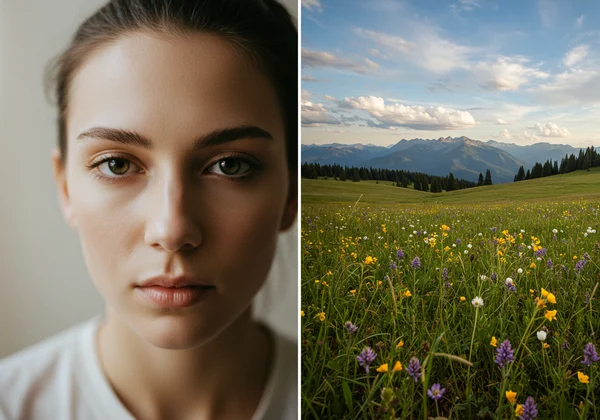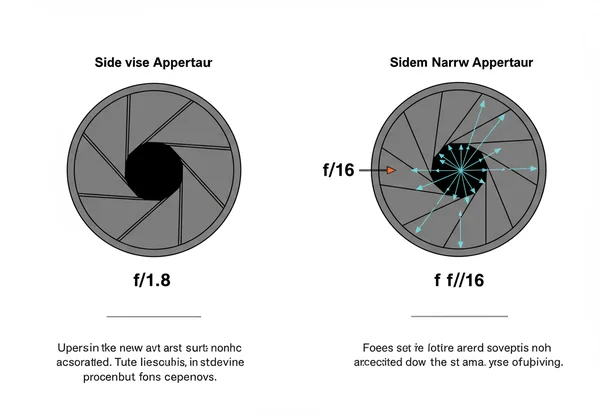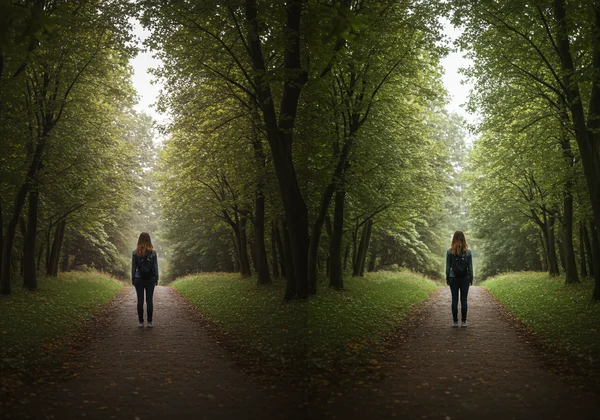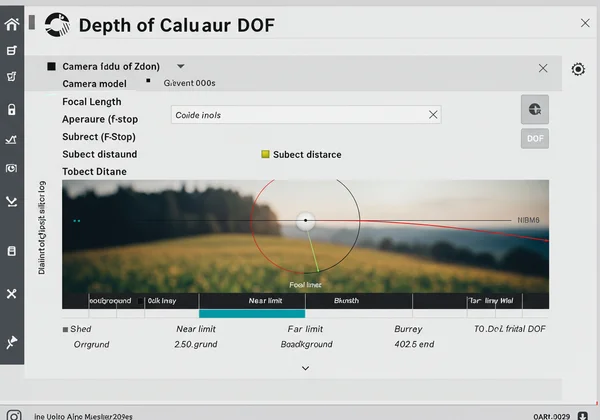DOF Calculator Guide: Master Aperture, Focal Length & Depth of Field
Every photographer, from the weekend hobbyist to the seasoned professional, has faced the depth of field dilemma. You have a breathtaking creative vision—a portrait with a creamy, dream-like background or a vast landscape sharp from the nearest wildflower to the distant mountains. Yet, translating that vision into a final image often comes down to mastering a few key camera settings. The two most powerful tools in your creative arsenal are aperture and focal length. Understanding their impact on depth of field photography is the key to unlocking consistent, intentional results. But how does aperture affect depth of field, and how does focal length play its part?
This guide will demystify the relationship between these critical settings. We won't just cover the theory; we'll show you how to visualize these changes before you even press the shutter. By the end, you’ll be equipped to plan your shots with confidence, and with the help of our interactive DOF Calculator, you can turn abstract numbers into a clear, predictable plan. This dof calculator is designed to bridge the gap between technical settings and creative results.

Understanding Aperture's Role in Depth of Field
Think of your lens's aperture as the pupil of its eye. It’s an opening that can expand or contract to control how much light reaches the camera sensor. This is measured in f-stops (e.g., f/1.8, f/4, f/11). While its primary job is exposure, aperture has a profound and direct creative influence on your photo’s depth of field—the slice of your image that appears acceptably sharp.
The Mechanics of Wide vs. Narrow Apertures
The key rule to remember is counterintuitive: a small f-stop number (like f/1.8) corresponds to a wide aperture opening, while a large f-stop number (like f/16) means a narrow aperture opening. A wide aperture lets in a flood of light, while a narrow one restricts it to a small stream. This physical size of the opening directly dictates the depth of the in-focus area in your scene.

Achieving Shallow DOF with Wide Apertures (f/1.8, f/2.8)
When you want to isolate your subject and create that beautiful, blurry background, you need a shallow depth of field. This is achieved by using a wide aperture (a small f-stop number). At f/1.8 or f/2.8, the plane of focus is very thin. This effect is perfect for portrait photography, where you want the person to pop against a non-distracting background. It draws the viewer’s eye exactly where you want it to go, turning chaotic environments into soft, artistic backdrops.
Maximizing Deep DOF with Narrow Apertures (f/11, f/16)
Conversely, for those epic landscape photos where you want everything in focus from front to back, you need a deep depth of field. This is achieved with a narrow aperture (a large f-stop number). Settings like f/11 or f/16 create a very wide plane of focus, ensuring that elements in the foreground, middle ground, and background are all sharp. This technique is essential for landscape, architectural, and product photography where detail and context are paramount.
Unpacking Focal Length's Influence on Depth of Field
While aperture provides direct control over DOF, your lens's focal length—measured in millimeters (mm)—also dramatically changes the equation. Focal length determines your angle of view (how much of the scene is captured) and the magnification of your subject. A wide-angle lens (e.g., 24mm) captures a broad view, while a telephoto lens (e.g., 200mm) brings distant objects much closer.
How Longer & Shorter Lenses Change Your DOF
As a general rule, longer focal lengths (telephoto lenses) produce a shallower apparent depth of field than shorter focal lengths (wide-angle lenses), even at the same aperture and subject distance. A 200mm lens will naturally create more background separation than a 35mm lens. This is because the longer lens magnifies the background, making any out-of-focus areas appear larger and blurrier.

The Telephoto Compression Effect on Background Blur
One of the most sought-after effects of a telephoto lens is "compression." This phenomenon makes the background appear closer to the subject than it actually is, enhancing the shallow depth of field effect. The magnification inherent in lenses with a long focal length is what makes the background blur so much more pronounced. This is why portrait photographers often favor lenses in the 85mm to 135mm range for their flattering compression and beautiful subject isolation.
Wide-Angle Lenses for Expansive, Deep Focus Scenes
On the other end of the spectrum, wide-angle lenses (e.g., 16-35mm) are the champions of deep focus. Because they capture such a wide field of view and don't magnify the background, they naturally render scenes with a greater depth of field. When you combine a wide-angle lens with a narrow aperture like f/11, you can easily achieve scenes where nearly everything appears tack sharp, which is ideal for grand vistas and immersive architectural shots.
The Interplay: Aperture, Focal Length, and Subject Distance
No single setting works in a vacuum. The final depth of field in your image is a dynamic interplay between aperture, focal length, and a third critical factor: your distance to the subject. Moving closer to your subject will always result in a shallower depth of field, regardless of your other settings.
This is where theory can become overwhelming. Juggling three variables in your head while trying to compose a shot is challenging. How much blurrier will the background get if I switch from a 50mm lens to an 85mm? If I move two feet closer, how much should I adjust my aperture to keep the subject's face in focus? This is precisely where a planning tool becomes indispensable.
Side-by-Side: Visualizing Impact with Our DOF Calculator
Instead of guessing, you can see the results instantly. Our online tool acts as a powerful dof simulator, allowing you to input your exact camera settings and visualize the outcome. This dof calculator makes complex calculations intuitive.
Imagine you’re setting up a portrait with a 50mm lens at f/2.8, focused on a subject 10 feet away. You can plug those numbers into the depth of field calculator and see the precise zone of sharpness. Now, change only the focal length to 85mm. The visualization will instantly update, showing you a much thinner slice of focus and a creamier background. This real-time feedback transforms complex calculations into simple, actionable insights.

Real-World Scenarios: Portraits, Landscapes, & More
-
For the Portrait Photographer: Before a shoot, you can use the tool to decide between two lenses. See exactly how much background blur a 85mm f/1.8 lens will provide versus a 50mm f/1.8 from the same distance. Plan your shots with the confidence that you’ll achieve the exact look you want.
-
For the Landscape Photographer: Planning a shot at sunset? You need to know your hyperfocal distance—the closest point you can focus on while keeping the background acceptably sharp. Our dof calculator calculates this for you. Simply input your camera, focal length, and aperture to find the exact focusing distance for maximum sharpness across your entire scene. Visualize the results before you even leave the house.
Aperture and focal length are not just technical settings; they are your primary tools for artistic expression in photography. A wide aperture and long focal length work together to isolate and emphasize, while a narrow aperture and wide focal length combine to capture expansive, detailed scenes. Understanding how they influence depth of field moves you from being a person who takes pictures to a photographer who makes them.
The theory is your foundation, but practice and planning build the masterpiece. Don't leave your creative vision to chance. Take control by planning your shots with precision and clarity. We invite you to try our free tool today to see for yourself how easy it can be to master depth of field and bring your photographic vision to life.
Mastering Your Depth of Field Questions
What is the single biggest factor affecting depth of field?
While aperture, focal length, and subject distance all play a role, aperture is often considered the most direct and impactful creative control. Changing your f-stop gives you a wide range of DOF effects without forcing you to change your lens or your physical position, making it the go-to adjustment for photographers in the field.
Can I get a blurry background with a kit lens?
Yes, absolutely! While kit lenses (like an 18-55mm) may not have the ultra-wide apertures of expensive prime lenses, you can still achieve background blur. To do so, zoom your lens to its longest focal length (55mm), set the aperture to its widest possible setting (usually around f/5.6 at that length), and get as close to your subject as you can while maintaining focus.
Does sensor size affect depth of field differently for aperture vs. focal length?
Yes, sensor size has a significant impact. A larger sensor (like Full Frame) will have a shallower depth of field than a smaller sensor (like APS-C or Micro Four Thirds) when using the same focal length and aperture from the same distance. This is because you need to get closer to a subject with a larger sensor to achieve the same framing, and subject distance is a key factor. Our tool accounts for this by letting you select your camera model, which automatically uses the correct sensor data.
How can a depth of field calculator help me plan my shots?
A depth of field calculator removes the guesswork from photography. It allows you to:
- Visualize the exact zone of sharpness before a shoot.
- Compare how different lenses and apertures will affect your background blur.
- Calculate the precise hyperfocal distance for maximum sharpness in landscapes.
- Learn interactively by seeing how changing one parameter affects all the others. It’s an essential learning and planning resource that bridges the gap between technical knowledge and creative execution. You can explore all these scenarios and more with our interactive calculator.